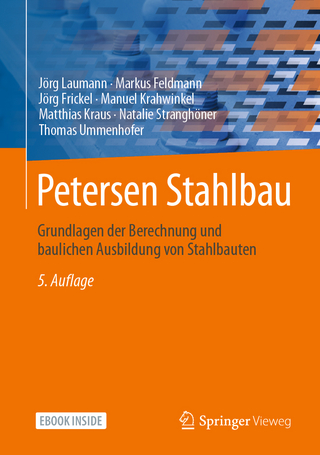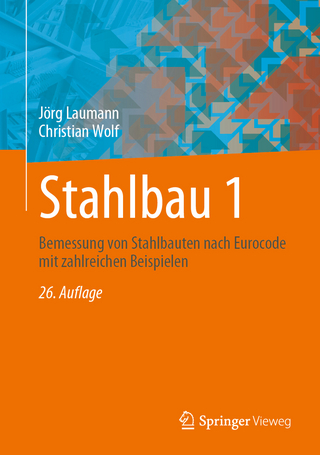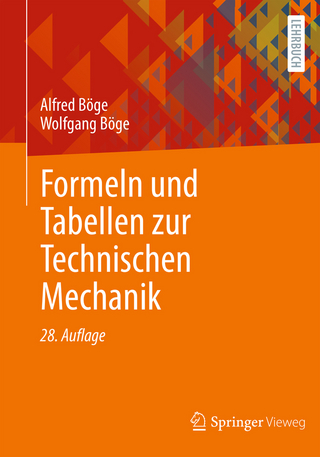
Dynamics of Structures
Pearson (Verlag)
978-0-13-290479-7 (ISBN)
- Titel erscheint in neuer Auflage
- Artikel merken
Dynamics of Structures includes many topics encompassing the theory of structural dynamics and the application of this theory regarding earthquake analysis, response, and design of structures. No prior knowledge of structural dynamics is assumed and the manner of presentation is sufficiently detailed and integrated, to make the book suitable for self-study by students and professional engineers.
Anil K. Chopra received his Bachelor of Science degree in Civil Engineering from Banaras Hindu University, India, in 1960, the Master of Science degree from the University of California, Berkeley, in 1963, and the Doctor of Philosophy degree, also from Berkeley, in 1966. After serving as an Assistant Professor at the University of Minnesota, Minneapolis, he joined the faculty at the University of California, Berkeley where he has served as Assistant Professor (1967-71), Associate Professor (1971-76), Professor (1976- ), Vice Chair (1980-83) and Chair (1991-93, 1994-97) of the Structural Engineering, Mechanics and Materials program in the Department of Civil and Environmental Engineering. He has been responsible for the development and teaching of courses in structural engineering, structural dynamics, and earthquake engineering. His research activities have included studies of structural dynamics, various problems in earthquake analysis and design of buildings, dynamic soil-structure interaction, dynamic fluid-structure interaction, and earthquake analysis and design of concrete dams. He has authored more than 300 published papers on this work, a monograph, Earthquake Dynamics of Structures, A Primer, 2005, and a textbook, Dynamics of Structures: Theory and Applications to Earthquake Engineering, 1995, 2001, and 2007. Professor Chopra serves as a consultant on earthquake engineering problems to numerous governmental and private organizations. He is a Member of the American Society of Civil Engineers, where he has served as Chairman (1986) of the Engineering Mechanics Division Executive Committee and also Chairman (1991) of the Structural Division Executive Committee. He was a member of the Board of Directors of the Earthquake Engineering Research Institute (1990-93), the Structural Engineers Association of Northern California (1987-89), the Seismological Society of America (1982-83), and the Applied Technology Council (1972-74). He served as a member of the Steering Committee for the Eighth World Conference on Earthquake Engineering, San Francisco, 1984, and as Chairman of the National Research Council Committee on Natural Disasters (1982-83). Currently, he serves as Executive Editor of Earthquake Engineering and Structural Dynamics, the journal of the International Association for Earthquake Engineering.
Foreword xxi
Preface xxiii
Acknowledgments xxxi
PART I SINGLE-DEGREE-OF-FREEDOM SYSTEMS 1
1 Equations of Motion, Problem Statement, and Solution
Methods 3
1.1 Simple Structures 3
1.2 Single-Degree-of-Freedom System 7
1.3 Force—Displacement Relation 8
1.4 Damping Force 12
1.5 Equation of Motion: External Force 14
1.6 Mass—Spring—Damper System 19
1.7 Equation of Motion: Earthquake Excitation 23
1.8 Problem Statement and Element Forces 26
1.9 Combining Static and Dynamic Responses 28
1.10 Methods of Solution of the Differential Equation 28
1.11 Study of SDF Systems: Organization 33
Appendix 1: Stiffness Coefficients for a Flexural
Element 33
2 Free Vibration 39
2.1 Undamped Free Vibration 39
2.2 Viscously Damped Free Vibration 48
2.3 Energy in Free Vibration 56
2.4 Coulomb-Damped Free Vibration 57
3 Response to Harmonic and Periodic Excitations 65
Part A: Viscously Damped Systems: Basic Results 66
3.1 Harmonic Vibration of Undamped Systems 66
3.2 Harmonic Vibration with Viscous Damping 72
Part B: Viscously Damped Systems: Applications 85
3.3 Response to Vibration Generator 85
3.4 Natural Frequency and Damping from Harmonic
Tests 87
3.5 Force Transmission and Vibration Isolation 90
3.6 Response to Ground Motion and Vibration
Isolation 91
3.7 Vibration-Measuring Instruments 95
3.8 Energy Dissipated in Viscous Damping 99
3.9 Equivalent Viscous Damping 103
Part C: Systems with Nonviscous Damping 105
3.10 Harmonic Vibration with Rate-Independent
Damping 105
3.11 Harmonic Vibration with Coulomb Friction 109
Part D: Response to Periodic Excitation 113
3.12 Fourier Series Representation 114
3.13 Response to Periodic Force 114
Appendix 3: Four-Way Logarithmic Graph
Paper 118
4 Response to Arbitrary, Step, and Pulse Excitations 125
Part A: Response to Arbitrarily Time-Varying Forces 125
4.1 Response to Unit Impulse 126
4.2 Response to Arbitrary Force 127
Part B: Response to Step and Ramp Forces 129
4.3 Step Force 129
4.4 Ramp or Linearly Increasing Force 131
4.5 Step Force with Finite Rise Time 132
Part C: Response to Pulse Excitations 135
4.6 Solution Methods 135
4.7 Rectangular Pulse Force 137
4.8 Half-Cycle Sine Pulse Force 143
4.9 Symmetrical Triangular Pulse Force 148
4.10 Effects of Pulse Shape and Approximate Analysis for
Short Pulses 151
4.11 Effects of Viscous Damping 154
4.12 Response to Ground Motion 155
5 Numerical Evaluation of Dynamic Response 165
5.1 Time-Stepping Methods 165
5.2 Methods Based on Interpolation of Excitation 167
5.3 Central Difference Method 171
5.4 Newmark’s Method 174
5.5 Stability and Computational Error 180
5.6 Nonlinear Systems: Central Difference Method 183
5.7 Nonlinear Systems: Newmark’s Method 183
6 Earthquake Response of Linear Systems 197
6.1 Earthquake Excitation 197
6.2 Equation of Motion 203
6.3 Response Quantities 204
6.4 Response History 205
6.5 Response Spectrum Concept 207
6.6 Deformation, Pseudo-velocity, and Pseudo-acceleration
Response Spectra 208
6.7 Peak Structural Response from the Response
Spectrum 217
6.8 Response Spectrum Characteristics 222
6.9 Elastic Design Spectrum 230
6.10 Comparison of Design and Response Spectra 239
6.11 Distinction between Design and Response
Spectra 241
6.12 Velocity and Acceleration Response Spectra 242
Appendix 6: El Centro, 1940 Ground Motion 246
7 Earthquake Response of Inelastic Systems 257
7.1 Force—Deformation Relations 258
7.2 Normalized Yield Strength, Yield Strength Reduction
Factor, and Ductility Factor 264
7.3 Equation of Motion and Controlling Parameters 265
7.4 Effects of Yielding 266
7.5 Response Spectrum for Yield Deformation and Yield
Strength 273
7.6 Yield Strength and Deformation from the Response
Spectrum 277
7.7 Yield Strength—Ductility Relation 277
7.8 Relative Effects of Yielding and Damping 279
7.9 Dissipated Energy 280
7.10 Supplemental Energy Dissipation Devices 283
7.11 Inelastic Design Spectrum 288
7.12 Applications of the Design Spectrum 295
7.13 Comparison of Design and Response
Spectra 301
8 Generalized Single-Degree-of-Freedom Systems 305
8.1 Generalized SDF Systems 305
8.2 Rigid-Body Assemblages 307
8.3 Systems with Distributed Mass and Elasticity 309
8.4 Lumped-Mass System: Shear Building 321
8.5 Natural Vibration Frequency by Rayleigh’s
Method 328
8.6 Selection of Shape Function 332
Appendix 8: Inertia Forces for Rigid Bodies 336
PART II MULTI-DEGREE-OF-FREEDOM SYSTEMS 343
9 Equations of Motion, Problem Statement, and Solution
Methods 345
9.1 Simple System: Two-Story Shear Building 345
9.2 General Approach for Linear Systems 350
9.3 Static Condensation 367
9.4 Planar or Symmetric-Plan Systems: Ground
Motion 370
9.5 One-Story Unsymmetric-Plan Buildings 375
9.6 Multistory Unsymmetric-Plan Buildings 381
9.7 Multiple Support Excitation 385
9.8 Inelastic Systems 390
9.9 Problem Statement 390
9.10 Element Forces 391
9.11 Methods for Solving the Equations of Motion:
Overview 391
10 Free Vibration 401
Part A: Natural Vibration Frequencies and Modes 402
10.1 Systems without Damping 402
10.2 Natural Vibration Frequencies and Modes 404
10.3 Modal and Spectral Matrices 406
10.4 Orthogonality of Modes 407
10.5 Interpretation of Modal Orthogonality 408
10.6 Normalization of Modes 408
10.7 Modal Expansion of Displacements 418
Part B: Free Vibration Response 419
10.8 Solution of Free Vibration Equations: Undamped
Systems 419
10.9 Systems with Damping 422
10.10 Solution of Free Vibration Equations: Classically
Damped Systems 423
Part C: Computation of Vibration Properties 426
10.11 Solution Methods for the Eigenvalue Problem 426
10.12 Rayleigh’s Quotient 428
10.13 Inverse Vector Iteration Method 428
10.14 Vector Iteration with Shifts: Preferred Procedure 433
10.15 Transformation of kφ = ω2mφ to the Standard
Form 438
11 Damping in Structures 445
Part A: Experimental Data and Recommended Modal
Damping Ratios 445
11.1 Vibration Properties of Millikan Library Building 445
11.2 Estimating Modal Damping Ratios 450
Part B: Construction of Damping Matrix 452
11.3 Damping Matrix 452
11.4 Classical Damping Matrix 453
11.5 Nonclassical Damping Matrix 462
12 Dynamic Analysis and Response of Linear Systems 465
Part A: Two-Degree-of-Freedom Systems 465
12.1 Analysis of Two-DOF Systems without Damping 465
12.2 Vibration Absorber or Tuned Mass Damper 468
Part B: Modal Analysis 470
12.3 Modal Equations for Undamped Systems 470
12.4 Modal Equations for Damped Systems 473
12.5 Displacement Response 474
12.6 Element Forces 475
12.7 Modal Analysis: Summary 475
Part C: Modal Response Contributions 480
12.8 Modal Expansion of Excitation Vector
p(t) = sp(t) 480
12.9 Modal Analysis for p(t) = sp(t) 484
12.10 Modal Contribution Factors 485
12.11 Modal Responses and Required Number of Modes 487
Part D: Special Analysis Procedures 494
12.12 Static Correction Method 494
12.13 Mode Acceleration Superposition Method 497
12.14 Mode Acceleration Superposition Method: Arbitrary
Excitation 498
13 Earthquake Analysis of Linear Systems 511
Part A: Response History Analysis 512
13.1 Modal Analysis 512
13.2 Multistory Buildings with Symmetric Plan 518
13.3 Multistory Buildings with Unsymmetric Plan 537
13.4 Torsional Response of Symmetric-Plan Buildings 548
13.5 Response Analysis for Multiple Support
Excitation 552
13.6 Structural Idealization and Earthquake Response 558
Part B: Response Spectrum Analysis 559
13.7 Peak Response from Earthquake Response
Spectrum 559
13.8 Multistory Buildings with Symmetric Plan 564
13.9 Multistory Buildings with Unsymmetric Plan 576
13.10 A Response-Spectrum-Based Envelope for
Simultaneous Responses 584
13.11 Response to Multi-Component Ground
Motion 592
14 Analysis of Nonclassically Damped Linear Systems 613
Part A: Classically Damped Systems: Reformulation 614
14.1 Natural Vibration Frequencies and Modes 614
14.2 Free Vibration 615
14.3 Unit Impulse Response 616
14.4 Earthquake Response 617
Part B: Nonclassically Damped Systems 618
14.5 Natural Vibration Frequencies and Modes 618
14.6 Orthogonality of Modes 619
14.7 Free Vibration 623
14.8 Unit Impulse Response 628
14.9 Earthquake Response 632
14.10 Systems with Real-Valued Eigenvalues 634
14.11 Response Spectrum Analysis 642
14.12 Summary 643
Appendix 14: Derivations 644
15 Reduction of Degrees of Freedom 653
15.1 Kinematic Constraints 654
15.2 Mass Lumping in Selected DOFs 655
15.3 Rayleigh—Ritz Method 655
15.4 Selection of Ritz Vectors 659
15.5 Dynamic Analysis Using Ritz Vectors 664
16 Numerical Evaluation of Dynamic Response 669
16.1 Time-Stepping Methods 669
16.2 Linear Systems with Nonclassical Damping 671
16.3 Nonlinear Systems 677
17 Systems with Distributed Mass and Elasticity 693
17.1 Equation of Undamped Motion: Applied Forces 694
17.2 Equation of Undamped Motion: Support
Excitation 695
17.3 Natural Vibration Frequencies and Modes 696
17.4 Modal Orthogonality 703
17.5 Modal Analysis of Forced Dynamic Response 705
17.6 Earthquake Response History Analysis 712
17.7 Earthquake Response Spectrum Analysis 717
17.8 Difficulty in Analyzing Practical Systems 720
18 Introduction to the Finite Element Method 725
Part A: Rayleigh—Ritz Method 725
18.1 Formulation Using Conservation of Energy 725
18.2 Formulation Using Virtual Work 729
18.3 Disadvantages of Rayleigh—Ritz Method 731
Part B: Finite Element Method 731
18.4 Finite Element Approximation 731
18.5 Analysis Procedure 733
18.6 Element Degrees of Freedom and Interpolation
Functions 735
18.7 Element Stiffness Matrix 736
18.8 Element Mass Matrix 737
18.9 Element (Applied) Force Vector 739
18.10 Comparison of Finite Element and Exact
Solutions 743
18.11 Dynamic Analysis of Structural Continua 744
PART III EARTHQUAKE RESPONSE, DESIGN, AND EVALUATION
OF MULTISTORY BUILDINGS 751
19 Earthquake Response of Linearly Elastic Buildings 753
19.1 Systems Analyzed, Design Spectrum, and Response
Quantities 753
19.2 Influence of T1 and Á on Response 758
19.3 Modal Contribution Factors 759
19.4 Influence of T1 on Higher-Mode Response 761
19.5 Influence of Á on Higher-Mode Response 764
19.6 Heightwise Variation of Higher-Mode Response 765
19.7 How Many Modes to Include 767
20 Earthquake Analysis and Response of Inelastic Buildings 771
Part A: Nonlinear Response History Analysis 772
20.1 Equations of Motion: Formulation and Solution 772
20.2 Computing Seismic Demands: Factors
To Be Considered 773
20.3 Story Drift Demands 777
20.4 Strength Demands for SDF and MDF Systems 783
Part B: Approximate Analysis Procedures 784
20.5 Motivation and Basic Concept 784
20.6 Uncoupled Modal Response History Analysis 786
20.7 Modal Pushover Analysis 793
20.8 Evaluation of Modal Pushover Analysis 798
20.9 Simplified Modal Pushover Analysis
for Practical Application 803
21 Earthquake Dynamics of Base-Isolated Buildings 805
21.1 Isolation Systems 805
21.2 Base-Isolated One-Story Buildings 808
21.3 Effectiveness of Base Isolation 814
21.4 Base-Isolated Multistory Buildings 818
21.5 Applications of Base Isolation 824
22 Structural Dynamics in Building Codes 831
Part A: Building Codes and Structural Dynamics 832
22.1 International Building Code (United States), 2009 832
22.2 National Building Code of Canada, 2010 835
22.3 Mexico Federal District Code, 2004 837
22.4 Eurocode 8, 2004 840
22.5 Structural Dynamics in Building Codes 842
Part B: Evaluation of Building Codes 848
22.6 Base Shear 848
22.7 Story Shears and Equivalent Static Forces 852
22.8 Overturning Moments 854
22.9 Concluding Remarks 857
23 Structural Dynamics in Building Evaluation Guidelines 859
23.1 Nonlinear Dynamic Procedure: Current Practice 860
23.2 SDF-System Estimate of Roof Displacement 861
23.3 Estimating Deformation of Inelastic SDF Systems 864
23.4 Nonlinear Static Procedures 870
23.5 Concluding Remarks 876
A Frequency-Domain Method of Response Analysis 879
B Notation 901
C Answers to Selected Problems 913
Index 929
| Erscheint lt. Verlag | 28.1.2012 |
|---|---|
| Sprache | englisch |
| Maße | 178 x 232 mm |
| Themenwelt | Technik ► Bauwesen |
| ISBN-10 | 0-13-290479-9 / 0132904799 |
| ISBN-13 | 978-0-13-290479-7 / 9780132904797 |
| Zustand | Neuware |
| Informationen gemäß Produktsicherheitsverordnung (GPSR) | |
| Haben Sie eine Frage zum Produkt? |
aus dem Bereich



